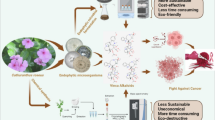Abstract
The effect of delta-9-tetrahydrocannabinol (delta-9-THC) on the growth kinetics and morphology of rat B103 neuroblastoma cells was assessed. Delta-9-THC in doses ranging from 10−4 to 10−7 M inhibited cellular growth in a dose-dependent fashion as evidenced by delay in doubling time, decrease in saturation density, and decrease in efficiency of plating. The inhibition in cellular growth was paralleled by dose-related alterations in cell morphology. Modifications included rounding of cells, retraction of neurites, blebbing of the cell surface, and exfoliation of the plasma membrane. Cytoplasmic alterations included distension of the endoplasmic reticulum, Golgi apparatus, and perinuclear space, and macrovacuolization. Intracytoplasmic laminated inclusions and vesicular clusters were suggestive of membrane repair in drug-treated cells. These morphological changes were accompanied by cytoskeletal rearrangement in the absence of significant alteration in the concentration of total cytoskeletal protein. Autoradiographic examination of the intracellular fate of 3H-delta-9-THC demonstrated that the drug was confined to the cytoplasmic compartment and often associated with macrovacuoles. These results suggest that delta-9-THC interacts with cellular membranes, thereby altering neuroblastoma cell growth and behavior.
Similar content being viewed by others
References
Becker Y, Schtram Y, Hadar J, Ben-hur T, Barasofsky A, Asher Y, Tabor E, Scemama A, Gilden HD (1984) Herpes simplex virus type 1 thymidine kinase gene controls virus pathogenesis and latency in the nervous system. In: Kohn A, Fuchs B (ed) Mechanisms of viral pathogenesis. Martinus Nijhoff, Boston, pp 293–308
Blevins RD, Regan JD (1976) Delta-9-tetrahydrocannabinol: effect on macromolecular synthesis in human and other mammalian cells. Arch Toxicol 35: 127–135
Blevins RD, Smith DP (1980) Effects of delta-9-tetrahydrocannabinol on cultured HeLa cell growth and development. Growth 44: 133–138
Brunk U, Collins VP, Arro E (1981) The fixation, dehydration, drying, and coating of cultured cells for SEM. J Microsc 123: 21–131
Cabral GA, McNerney PJ, Mishkin EM (1986) Delta-9-tetrahydrocannabinol enhances release of herpes simplex virus type 2. J Gen Virol 67: 2017–2022
Carrasco L, Smith AE (1976) Sodium ions and the shut-off of host cell protein synthesis by picornaviruses. Nature (London) 264: 807–809
Carrasco L, Smith AE (1980) Molecular biology of animal virus infection. Pharmacol Ther 9: 311–355
End DW, Thoursen K, Dewey WL, Carchman RA (1977) A comparative study of the disposition of (−)-delta-9-tetrahydrocannabinol in neuroblastoma and glioma cells in tissue culture: Relation to cellular impairment. Mol Pharmacol 13: 864–871
Garry RF, Waite MRF (1979) Na+ and K+ concentrations and the regulation of the interferon system in chick cells. Virology 96: 121–128
Garry RF, Bishop JM, Parker S, Westbrook K, Lewis G, Waite MRF (1979) Na+ and K+ concentrations and the regulation of protein synthesis in sindbis virus-infected chick cells. Virology 96: 108–120
Garry RF, Vlue ET, Bose HR (1982) Membrane-mediated alterations of intracellular Na+ and K+ in lytic-virus-infected and retrovirus-transformed cells. Biosci Rep 2: 617–623
Howlett AC (1984) Inhibition of neuroblastoma adenylate cyclase by cannabinoid compounds. Life Sci 35: 1803–1810
Howlett AC, Fleming RM (1984) Cannabinoid inhibition of adenylate cyclase. Pharmacology of the response in neuroblastoma cell membranes. Mol Pharmacol 26: 532–538
Issedorides MR (1985) Cannabis and arginyl proteins. In: Harvey DJ (ed) Proceedings of the 9th International Congress of Pharmacology: 3rd satellite symposium on cannabis. IRL Press, Oxford, pp 411–418
Kelly LA, Butcher RW (1979) Effects of delta-1-tetrahydrocannabinol on cyclic AMP in cultured human diploid fibroblasts. J Cyclic Nucleotide Res 5: 303–313
Leopardi E, Friend DS, Rosenau W (1984) Target cell lysis: ultrastructural and cytoskeletal alterations. J Immunol 133: 3429–3436
Meyers WA, Heath RG (1979) Cannabis sativa: ultrastructural changes in organelles of neurons in brain septal region of monkeys. J Neurosci Res 4: 9–17
Mishkin EM, Cabral GA (1985) Delta-9-tetrahydrocannabinol decreases host resistance to herpes simplex virus type 2 vaginal infection in the B6C3F1 mouse. J Gen Virol 66: 2539–2549
Mollenhauer HH (1964) Plastic embedding mixtures for use in electron microscopy. Stain Technol 39: 111–114
Mon MJ, Jansing RL, Doggett S, Stein JL, Stein GS (1978) Influence of delta-9-tetrahydrocannabinol on cell proliferation and macromolecular biosynthesis in human cells. Biochem Pharmacol 21: 1759–1765
Nahas GG, Morishima A, Desoize B (1977) Effect of cannabinoids on macromolecular synthesis and replication of cultured lymphocytes. Fed Proc 36: 1748–1752
Poddar MK, Mitra G, Ghosh JJ (1978) Delta-9-tetrahydrocannabinol-induced changes in brain ribosomes. Toxicol Appl Pharmacol 46: 737–757
Pringle HL, Bradley SG (1978) Mechanism of action of immunosuppressive cannabinoids. Fed Proc 37: 1651
Rosenau W, Burke GC, Moy J (1979) Lymphotoxin-induced loss of plasma-membrane protein. Am J Pathol 94: 473–482
Rosenau W, Burke GC (1982) Lymphotoxin-induced changes in target-cell plasma membrane protein: enhancement of synthesis and content. Cell Immunol 67: 14–22
Rosenau W, Burke GC, Anderson R (1981) Effects of lymphotoxin on target-cell plasma-membrane lipids. Cell Immunol 60: 144–154
Schanne AX, Kane AB, Young EE, Farber JL (1979) Calcium dependence of toxic cell death: a final common pathway. Science 206: 700–702
Symington J (1984) Electrophoretic transfer of proteins from two-dimensional gels to sheets and their detection. In: Celis JE, Bravo R (ed) Two-dimensional gel electrophoresis of proteins: methods and applications. Academic Press, New York pp 127–168
Wing DR, Leuschner JTA, Brent GA, Harvey DJ, Paton WDM (1985) Quantification of in vivo membrane-associated delta-1-tetrahydrocannabinol and its effect on membrane fluidity. In: Harvey DJ (ed) Proceedings of the 9th International Congress of Pharmacology: 3rd satellite symposium on cannabis. IRL Press, Oxford, pp 411–418
Author information
Authors and Affiliations
Rights and permissions
About this article
Cite this article
Cabral, G.A., McNerney, P.J. & Mishkin, E.M. Interaction of delta-9-tetrahydrocannabinol with rat B103 neuroblastoma cells. Arch Toxicol 60, 438–449 (1987). https://doi.org/10.1007/BF00302387
Received:
Accepted:
Issue Date:
DOI: https://doi.org/10.1007/BF00302387




